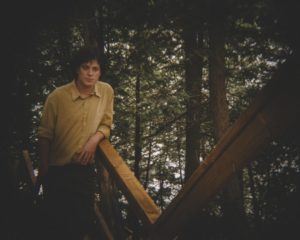Jonathan Personne takes his leave from reality on Disparitions, a collection of 10 dark, orchestral tracks. With hints of rock, garage and “yé-yé” (for the older crowd) music, it offers a somewhat improved vision of the time-period extending from the end of the 1960s through the next decade. An exercise in nostalgia for an era Personne missed entirely.
“Terre des Hommes” [the French version of Man and His World, from Montreal’s Expo 67] presents a certain idea of Parc Jean-Drapeau, and the ruins of Expo. “Alone before history,” Personne sings, in a voice full of echo, on the song – which sounds like it was molded in equal parts by the naiveté of an bygone period, and the disenchantment of our own time. It’s as if Personne was able to unearth the latest traces and artifacts of a lost Montréal, and turn them into something perfectly current, vaguely sci-fi, and ecologically committed.
“Sure, I wanted to come back to subject matter had already covered on the first album, namely the end of the world,” says Personne. “I still wanted to use fairly graphic stuff, like people embarking on space ships to leave the planet before it blows. It’s a tragedy, I know, but I was having fun trying to visualize it.”
An occasional music video producer and illustrator, Jonathan Personne (born Robert) is driven by elaborate arrangements, loaded with flutes, Fender Rhodes keyboards, and animal sounds – like those of the birds and the dog that can be heard on “Disparitions.” He’s created a sonic universe whose surprising instrumentation and rich textures approximate film music. The multi-disciplinary artist is looking forward to being able to create the soundtrack of his own film someday. Even now, he’s creating a short film – but refuses to say what it’s about at this time.
Personne’s ability to mix sounds and sights in such a natural way can probably be explained by the fact that he is a synesthete (one who sees sounds as colours), as are Philémon Cimon, Thom Yorke, and Billie Eilish, among others. Synesthesia is less rare among professional musicians than we think it is.
“The album cover isn’t purple, but that’s the colour I associate with this opus,” says Personne. “I also see some green when I listen to the songs. For Corridor’s Junior album, the main three colours are blue, a shade of burgundy, and a sort of slightly ochre yellow… I think that synesthesia, a word I learned two weeks ago, is feeding me as an illustrator. Music and the visual arts always influence one another, and I don’t tend to see things in black and white. Strong visuals are very, very important for an artist, particularly if you don’t have an outsized personality.”
 Disparitions was put together in the wake of the release of the album Junior, by Personne’s band, Corridor, on the prestigious U.S. label Sub Pop Records. This collection of solo songs reflects the burnout Personne was going through, at a time when all his dreams seemed to be coming true. While that whirlwind has proven creatively beneficial, he’s planning to slow down somewhat from now on.
Disparitions was put together in the wake of the release of the album Junior, by Personne’s band, Corridor, on the prestigious U.S. label Sub Pop Records. This collection of solo songs reflects the burnout Personne was going through, at a time when all his dreams seemed to be coming true. While that whirlwind has proven creatively beneficial, he’s planning to slow down somewhat from now on.
“The story of that album is still rather unusual, and that was what caused it to be written in the first place” he says. “I was experiencing a massive work overdose, a contradictory period, during which I was fighting fire with fire by throwing myself into one more project at a time when I had overextended myself… It was also a lesson. In future, I’ll be able to say no.”
Immortalized on tape and alongside Guillaume Chiasson (Ponctuation, Bon Enfant), whose trademark as a technician is analog recording, Disparitions is the result of a fair level of risk-taking. Producer Emmanuel Ethier then had to deal with the occasional small bit of feedback, or mistake, that make the tracks sound even more organic.
“‘A mistake that sounded good,’ that’s Corridor’s motto since we recorded our first album,” says Personne. “We reserve the right to fail. To err is human, so that way we don’t sound like we’re robots.
“When it’s too pretty,” he adds, “it becomes ugly.”
Onstage Sept. 23 as part of Pop Montréal